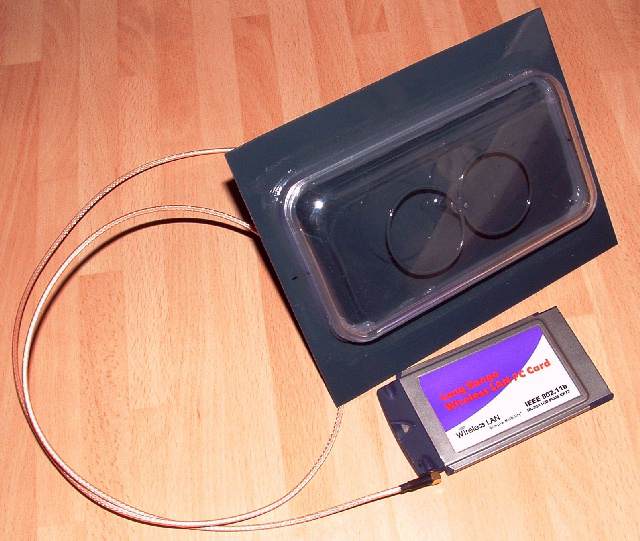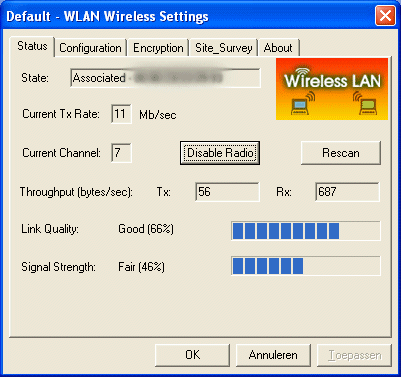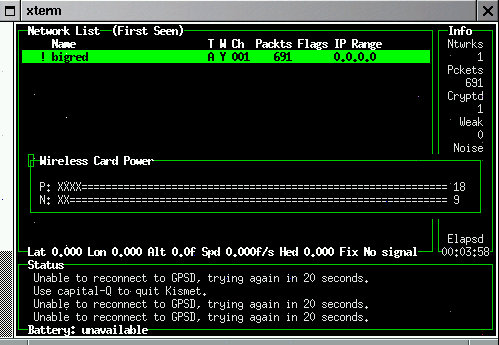Homebrew Wifi antenna test page
By PE2ER for Wireless Nederland – Portal and forum
|
Homebrew Wifi antenna test page By PE2ER for Wireless Nederland – Portal and forum
|
Congratulations! You have just
successfully completed your homebrew antenna project!
After all this effort, you are left with only one question: Was it worth the
effort? Does the antenna life up to your expectations? There are two ways of
finding out:
Test Homebrew Wifi antennas - Without the use of special equipment.
Not everyone has measurement equipment for testing 2.4GHz antennas laying around ;-) There are however some simple tests you can perform to establish if an antenna behaves as an antenna, or an elaborate air-cooled 'dummy-load'.
For the method described here, we make use of standard Radio LAN equipment to assess your homebrew antenna. The test will give a fairly good idea if the antenna functions as an antenna ... or not. For a more specific results, sadly you will need more specialised equipment.
You will need an Access Point as an RF Signal generator and a Wifi client to determine signal levels. The Antenna Under Test (AUT) can be connector to the Access Point (or wireless router, as a transmit-antenna) or to the client (as receiving-antenna). Antenna parameters have reciprocity – This means that an antennas parameters are the same in both directions; transmitting and receiving. You can either connect the Antenna Under Test to either an Access Point or Wifi Client to test it.
Connect the antenna with a minimal length of coaxial cable. The cable must be suitable for the frequency and should have the lowest loss possible. This minimises the effect of the coaxial cable on the measurement results. Make sure that the connection is secure. Nothing is more frustrating than an intermittent contact during measurement.

Figure: Senao NL-2511CD plus Ext 2 PCMCIA card and a biloop antenna connected for testing.
For a reliable measurement you must get a descent distance between the antennas of the Access Point and Client. 10 to 20 meter will do just fine. Best results are obtained with measurements in free space. En open field is ideal, but may not be practical. You may use an Access Point that is part of somebody else's network, just as long as you have an idea about the physical location of that AP.
In the following description, I assume that the AUT is connected to the Wifi client, as shown in the picture above. An access Point is used as a signal source, using its standard antenna.
You can choose either one of both options that follow to perform the measurement.
Make use of the Signal Strength indication in the utility software supplied with the card, or

....more convenient, use a program like Network Stumbler or Kismet.
"Antenne roteren - Polarisatie" means Rotate antenna -
Polarisation
"Antenne roteren - Richteffect" means Rotate antenna - Directionality
"Antennekabel los" means disconnected antenna cable

(Screenshot provided by Bigred)
If you use the utility software, connect your client to the reference Access Point. Simply read the value from the "Signal Strength" bar shown in most utility programs.
When you use Netstumbler, this is not required. Simply start it up, and select the reference AP from the list by double-clicking on it. The stronger the received signal, the higher the green area will be.
Test 1 - Signal strength with and without antenna
The paragraph title says it all. Simply measure the signal strength with and without an antenna connected to your Wifi client. The must be a clearly noticeable difference. If signal level is low and connecting the antenna has no effect, improve the alignment between the antennae on the Access Point and the client. Also inspect the connecting cable, or try to connect another (known good) antenna to it if you have one available. Last, reduce the distance between the Access Point and the Client.
If signal level is high with and without the external antenna connected, try increasing the distance between the two devices.
Directional antennas have an effect on radio waves like a torchlight on light. Most energy is bundled in a beam at the front of the antenna. To the side and rear of the antenna, the signal level is less. Turn the antenna around the vertical axis. You must notice a clear difference in signal strength during the rotation. Make sure not to shield (part of) the antenna with your body.
Omni's (Omni directional Antennas) have no directivity. This means that you should notice little or no variations in signal strength when the antenna is rotated around its vertical axis. You should however notice a change in signal strength when the antenna is tilted towards the Access Point. If the signal strength increases, the antenna has what is called an electrical 'uptilt'. If the signal strength increases when the antenna is tilted away from the AP, the antenna has an electrical 'downtilt'.

Te testen antenne = Antenna Under Test
Polarisatie = Polarisation
Richteffect = Directivity
Access Point met Omni = Access Point with Omni directional antenna
Directional and Omni directional antennas both have a parameter called polarisation. Antenna polarisation is defined as the direction of the Electric field of the antenna, in reference to the earth's horizon. Most commonly used are horizontal and vertical polarisation. A standard Wifi equipment dipole antenna has vertical polarisation, when mounted vertically. An antenna with vertical polarisation performs at his best in conjunction with another vertically polarised antenna. When antennas with different polarisation are mixed, the result is a decrease in signal strength - the so called cross-polarisation rejection. This effect must be clearly present with your antenna.
Rotate the antenna around the horizontal axis, keeping the front of the antenna pointed toward the Access Point's Antenna. You must be able to distinct a clear maximum and minimum in signal strength.
Another form of polarisation is found in the Helical or Helix antenna. This antenna has a circular polarisation. The signal strength should remain constant when this antenna is rotated around its bore sight.
If the antenna responds as expected in all three tests, you can assume that your antenna indeed functions as an antenna. Whether or not the antenna delivers the gain that you expect an only be estimated by comparing the results of this antenna with those of an antenna with known gain. Maximum signal strength received should be about equal for both antennas.
As indicated above, some programs/ cards indicate signal strength in linear percent scale (0-86% in my case), whilst others (Netstumbler) do the same in dBm, a logarithmic scale. In theory you are able to determine the absolute gain of an antenna in dBi by comparing the signal strength (in dBm) of two antennas. The difference in signal strength in dBm is the same as the difference in gain in dBi between those two antennas. If you have a signal; strength op -60dBm on a dipole antenna (2dBi gain) and a signal strength of -50dBm using the Antenna Under Test, than the gain of the AUT is 2dBi + (-50dBm - -60dBm) = 12dBi.
Unfortunately, you can not trust the indicated signal strength to be absolutely true. The indicated signal strength in Netstumbler is just an interpretation of the signal reported by the chipset in your Wifi card. In most cases, the signal strength detector is not even a logarithmic scale, but a linear one. This means that it is not possible to determine the absolute gain of your antenna. It is however possible to determine the relative gain of an antenna. i.e.: Is its gain more, loss or equal to that of the reference antenna.
Relative Indicated Sign al Strength Indication (RSSI) is also dependent on the chipset used in your equipment. You can not compare Signal Strength between two different cards (even of the same type!) and expect to gain meaningful results.
Test hombrew Wifi antennas - using measurement equipment
Thé most widely used antenna test equipment with amateur antenna builders is the VSWR meter (Voltage Standing Wave Ratio meter). Using an SWR meter an an RF Generator, it is possible to determine if an antenna is correctly tuned to a frequency. A Homebrew VSWR meter, designed specifically for use with Wifi equipment, can be found here.
The gain of an antenna can be determined on an antenna-range. A Simplified antenna-range, and a protocol on how to perform the measurement with the use of simple homebrew equipment, can be found on my Practical Wifi antenna measurements page.
The Internet community "Wireless Nederland" organises a yearly event called WOAF (Wifi Open Air Festival) where antenna gain is measured using professional equipment.
http://www.wirelessnederland.nl Wireless Nederland – Internet community with a fast amount of Wifi knowledge